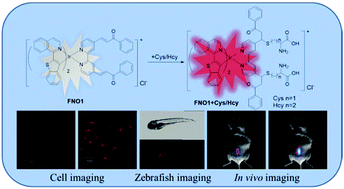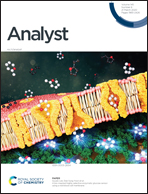A near-infrared phosphorescent iridium(iii) complex for fast and time-resolved detection of cysteine and homocysteine†
Abstract
Thiol-containing amino acids, cysteine (Cys) and homocysteine (Hcy), play crucial roles in the biosystem; their abnormal contents in the cells are linked to many diseases. Herein, we designed and synthesized a novel near-infrared (NIR) phosphorescent iridium(III) complex-based probe (FNO1) that can detect Cys and Hcy in real-time in the biosystem. Due to the advantages of the iridium complex, the FNO1 probe had excellent chemical stability and photostability, high luminescence efficiency, and long luminescence lifetime. In addition, the probe showed a fast response, high sensitivity, and low cytotoxicity. As verified by high resolution mass spectra (HR-MS) and density functional theory (DFT) calculations, the detection was achieved through the addition of the α,β-unsaturated ketone group in FNO1 by the nucleophilic thiol group in Cys and Hcy. Through time-resolved emission spectroscopy (TRES) and in the presence of a strongly fluorescent dye rhodamine B, the FNO1 probe could detect Cys and Hcy due to its long luminescence lifetime (260/197 ns). Finally, owing to its NIR-emitting properties, the FNO1 probe was successfully applied in the imaging of Cys and Hcy in living cells, zebrafish, and mice.



 Please wait while we load your content...
Please wait while we load your content...